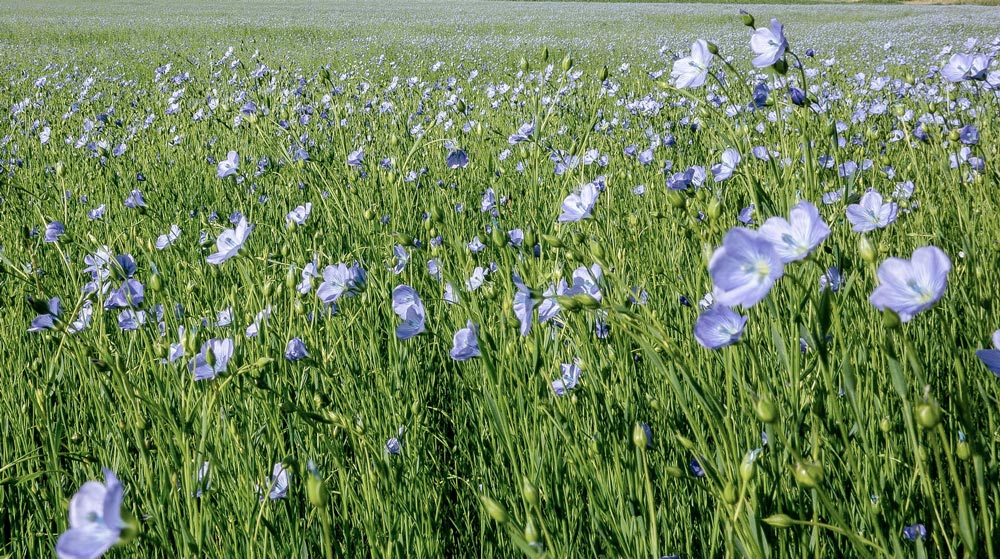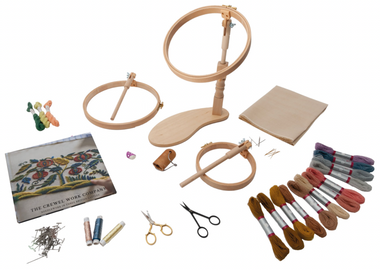Many years specialising in crewel work and exploring our passion for historic textiles have taught us to use only the highest quality materials to obtain the best results from our embroidery.
We thought we would share with you our recent research challenge as we set about sourcing a historically accurate 'Elizabethan' even-weave linen for our range of Elizabethan needlework kits (we don't just do crewel work!).

Ian Dale from Angus Weavers in Scotland
For over 25 years now our weaver Ian Dale of Angus Weavers in Scotland has provided us with the best linen available and has worked with us to develop our beautiful ‘Z’ twist Jacobean Linen Twill, which faithfully replicates linen used for crewel embroideries during the 17th and 18th Centuries.

Linen Twill Featured with the Jacobean Fantasy Design
As many of our customers will know, we can't get enough of our twill and whenever we are with Ian we always reaffirm how essential is it to maintain the high quality of ground fabric and the importance of this to embroiderers. Ian will, in turn, remind us that most commercially available linen is disastrously below par, being bleached to remove the grey residue from pollution and then chemically dyed to achieve a 'natural' colour. These chemicals destroy the lovely smoothness of the threads within the cloth, which in turn shreds the wool as you embroider. By contrast, Ian's linen is produced from flax grown far enough away from pollution to produce the natural ‘oatmeal with honey’ colour.
Perfect! We always knew our linen twill couldn't be beaten. But we were now venturing into unknown territory, that of even-weave linen.
Having never supplied a linen of this kind in our kits before we were concerned to get it right and to make sure it would be as wonderful as our twill. After all, we have worked with our weaver for long enough to know not to make assumptions about the quality of commercially available linens.
It needed to be the perfect weight and colour for the kits we were about to produce and most importantly, we wanted it to stand the test of time, just as the historic artefacts we study on our retreats have, even those produced over 400 years ago.

We had in depth discussions with Ian about what we needed and it was only then that we realised the true reality of the situation. Ian had recently visited a Scottish Castle to examine a piece of historic embroidery restored in the latter half of the 20th century and he was shocked by the deterioration the piece had suffered in such a short time. In fact, never had he seen such deterioration of a relatively new piece of ground fabric. This caused him to investigate further and enlist the expertise and research resources of a Scottish University.
Together they set about testing the combined effects of modern pollution on the growing and cultivation of flax, the effects of chemicals used in the linen finishing process, and the effects of modern air and light pollution on the ageing process of embroidered ground fabric. Their results provided startling conclusions about the real quality and longevity of modern commercial linens, with important implications for the embroideries we painstakingly produce today.
Shockingly, their conclusion was that the combination of the factors they tested, namely pollution, light damage, as well as dyeing and ‘finishing’ methods on the linen, all found in the production of most modern linen, will mean that much of the linen available in the market today, is not destined to survive more than 60 years.
This made us determined to make sure the even-weave linen we supplied was of the standard we expected.
Our New Elizabethan Linen
With this in mind, like we had done decades ago with our linen twill, we began discussing with Ian how to produce a new even-weave linen, that would not only faithfully replicate the qualities of historic linen, but which would crucially last for hundreds of years rather than just a few decades.

The linen Ian has since created for us took over a year to develop. Naturally, it uses organically grown flax and the thread is produced using an ancient spinning method which creates a far rounder thread than the usual modern flattened version. The woven cloth is boil washed to a near white and is neither bleached or dyed. The joy of this linen is that it replicates that produced and used by our forebears, using the same weaving methods of hundreds of years ago.
This, as you might expect, was extremely pleasing!
We are delighted to now be able to include this linen in our new range of silk and goldwork embroideries and will soon be able to sell it by the metre for those who would like to create their own design with linen they know they can rely on.

The first kits using our 'Elizabethan' linen are our new Elizabethan kits featuring silk embroidery and gold work and there will be many more to come.
Our linen is now available from our Linens section of our website.






